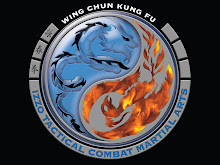The strength of 90
There is a concept of not letting your guard getting outstretched or drawn past the point of 90 degrees.
In Wing Chun we offer our Man Sau / Wu Sau guard hands a bit further outstretched than most other fighting styles do.
Consider the close guard of the boxer or the drop guard of some kickboxing styles. Even Muay Thai has a high guard, yet the position of the hands in relation to the elbows are within the plane of a 90 degree angle.
The goal of an attack on our enemy is to strike their body (centerline) and not their arms. After all, the arms are controlled by the body. If I hold my hands up in a guard position, the initial point of contact for my torso from my guard is a matter of inches, however, if I hold my hands up in my Wing Chun guard, the span of safety I have from contact with my hands to my torso greatly increases.
The issue then becomes being aware of our greatest strength and balance within our arm's reach.
Learning to feel energy (be it incoming or pulling) and the effect it has on your balance is necessary to understanding how much you can take with your body as a unit.
Have your training partner place his/her hands on your forearm and begin to slowly push into your core. Starting from a Man Sau guard, allow the energy to come into your core and determine how far past 90 degrees before you start to feel uncomfortable with your balance.
Do the same with a Wing Chun Lap Sau from your Wu Sau position...feel how far your balance will hold with increasing pulling energy before you start to fall forward.
You will learn how far forward and how far drawn in you can be before your fighting balance seems to suffer.
Dominick Izzo
For Wing Chun Self Defense Classes in the Chicago area visit, www.izzo-training.com
In Wing Chun we offer our Man Sau / Wu Sau guard hands a bit further outstretched than most other fighting styles do.
Consider the close guard of the boxer or the drop guard of some kickboxing styles. Even Muay Thai has a high guard, yet the position of the hands in relation to the elbows are within the plane of a 90 degree angle.
The goal of an attack on our enemy is to strike their body (centerline) and not their arms. After all, the arms are controlled by the body. If I hold my hands up in a guard position, the initial point of contact for my torso from my guard is a matter of inches, however, if I hold my hands up in my Wing Chun guard, the span of safety I have from contact with my hands to my torso greatly increases.
The issue then becomes being aware of our greatest strength and balance within our arm's reach.
Learning to feel energy (be it incoming or pulling) and the effect it has on your balance is necessary to understanding how much you can take with your body as a unit.
Have your training partner place his/her hands on your forearm and begin to slowly push into your core. Starting from a Man Sau guard, allow the energy to come into your core and determine how far past 90 degrees before you start to feel uncomfortable with your balance.
Do the same with a Wing Chun Lap Sau from your Wu Sau position...feel how far your balance will hold with increasing pulling energy before you start to fall forward.
You will learn how far forward and how far drawn in you can be before your fighting balance seems to suffer.
Dominick Izzo
For Wing Chun Self Defense Classes in the Chicago area visit, www.izzo-training.com

